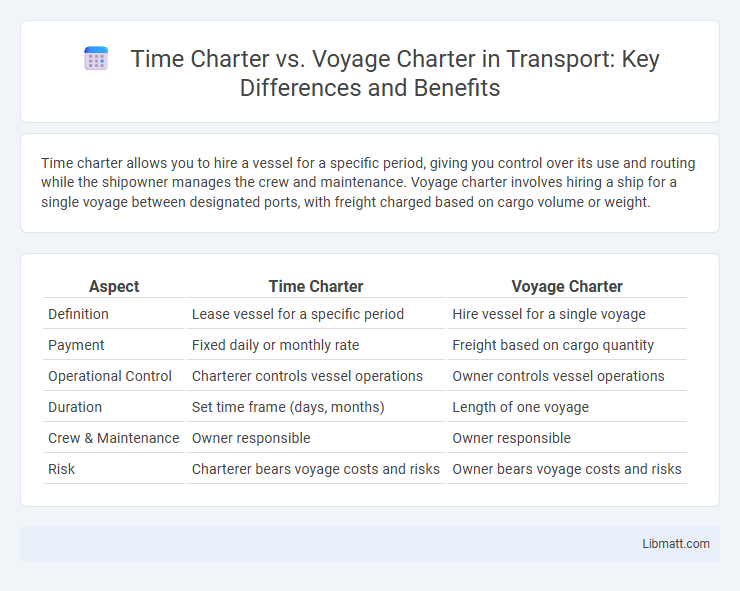Time charter allows you to hire a vessel for a specific period, giving you control over its use and routing while the shipowner manages the crew and maintenance. Voyage charter involves hiring a ship for a single voyage between designated ports, with freight charged based on cargo volume or weight.
Table of Comparison
| Aspect | Time Charter | Voyage Charter |
|---|---|---|
| Definition | Lease vessel for a specific period | Hire vessel for a single voyage |
| Payment | Fixed daily or monthly rate | Freight based on cargo quantity |
| Operational Control | Charterer controls vessel operations | Owner controls vessel operations |
| Duration | Set time frame (days, months) | Length of one voyage |
| Crew & Maintenance | Owner responsible | Owner responsible |
| Risk | Charterer bears voyage costs and risks | Owner bears voyage costs and risks |
Introduction to Charter Types
Time charter and voyage charter represent distinct shipping agreements tailored to different logistical needs. Time charter involves hiring a vessel for a specific period, granting you control over its commercial operations within that timeframe. Voyage charter contracts the ship for a particular journey, with the owner responsible for vessel operations and costs during the voyage.
Defining Time Charter
Time charter is a maritime contract where the charterer hires a vessel for a specified period, gaining operational control while the shipowner manages crewing and maintenance. This arrangement allows the charterer to direct the ship's commercial use, such as route and cargo, but the owner retains responsibility for the vessel's seaworthiness. Time charters differ from voyage charters, which are contract-specific to a single voyage with defined cargo and route parameters.
What is a Voyage Charter?
A Voyage Charter is a contract where the shipowner agrees to transport a specified cargo between designated ports for a fixed price. The charterer pays freight based on the quantity of cargo shipped, while the owner covers operational expenses such as fuel and port charges. This type of charter is commonly used for single trips and offers flexibility in route and scheduling.
Key Differences Between Time and Voyage Charters
Time charters involve hiring a vessel for a specific period during which you control its commercial operations, while voyage charters contract the ship for a single journey between designated ports. In time charters, you pay hire based on the duration of the charter, but in voyage charters, freight is calculated per ton of cargo or lump sum for the voyage. The key difference lies in operational control and payment structure, with time charters offering flexibility over multiple voyages and voyage charters focusing on cost efficiency for one trip.
Responsibilities of Shipowners
Shipowners under a time charter are responsible for providing a seaworthy vessel and maintaining its operational readiness throughout the charter period, while the charterer manages the cargo and voyage details. In a voyage charter, shipowners bear greater responsibility, including managing the vessel's navigation, crew, and fuel expenses, as well as ensuring delivery of the cargo to the specified destination. Understanding these distinctions helps you assess risk allocation and operational control in maritime contracts.
Charterer’s Duties and Obligations
In a time charter, the charterer is responsible for paying hire and providing voyage instructions while the shipowner manages vessel operations and crew. Under a voyage charter, the charterer's primary duty is to supply cargo and pay freight, with the shipowner handling navigation, crew, and operational decisions. The charterer in a time charter bears costs such as fuel and port charges during the charter period, whereas in a voyage charter, these costs are typically the shipowner's responsibility.
Cost Structures and Payment Terms
Time charter agreements require You to pay a fixed daily hire rate covering vessel operation for a specified period, often including fuel and port charges separately. Voyage charters involve payment based on a lump sum or freight rate per ton for a specific cargo trip, with owners typically bearing voyage-related costs such as fuel and port fees. Understanding these distinct cost structures and payment terms is crucial for optimizing freight expenses and operational budgeting.
Legal Considerations and Common Disputes
Time charters and voyage charters differ significantly in their legal frameworks, with time charters governed primarily by the charter party agreement focusing on vessel availability and hire duration, while voyage charters emphasize the completion of a specific cargo shipment under a contract of carriage. Legal disputes often arise in time charters over off-hire periods, redelivery conditions, and maintenance obligations, whereas voyage charters frequently encounter conflicts related to laytime calculation, demurrage claims, and deviations from agreed routes. Understanding these distinctions is critical for maritime lawyers and charterers to mitigate risks and resolve conflicts effectively in shipping contracts.
Advantages and Disadvantages of Each Charter
Time charter offers flexibility by allowing you to control the vessel for a specified period, enabling efficient route planning and cargo handling, but it may incur higher operational costs and requires managing vessel performance risks. Voyage charter provides cost predictability with a fixed price per voyage and less operational responsibility, though it limits your control over scheduling and may result in delays if the ship encounters unforeseen issues. Choosing between the two depends on your priority for operational control versus cost certainty and risk management.
Choosing the Right Charter for Your Shipping Needs
Choosing between a time charter and a voyage charter depends on your shipping requirements and control preferences. A time charter allows you to hire a vessel for a specific period, offering flexibility in routing and scheduling, ideal for ongoing shipping needs. In contrast, a voyage charter is better for a single, defined shipment with a fixed route and price, minimizing risk and simplifying cost management for your cargo transport.
time charter vs voyage charter Infographic

 libmatt.com
libmatt.com